How to Identify the Perfect Catfish to Raise, Choosing the appropriate species of catfish is essential to building a successful and profitable fish farm.
Thorough study of different species—each with distinct traits and growth patterns—is the first step toward successful catfish farming.
Comprehending the optimal environmental parameters for catfish farming is crucial since it directly impacts the fish’s well-being and growth speeds.
Moreover, putting effective feeding procedures into place guarantees ideal growth, optimizing size and market value.
The selection process takes into account a number of factors, such as water quality, tolerance to temperature changes, and regional adaptation.
A sustainable and successful endeavor begins with selecting a catfish variety that is compatible with the farm’s geographic location and available resources.
Adopting cutting-edge technology in aquaculture also improves output and overall efficiency, ranging from sophisticated water filtration systems to data-driven monitoring.
Essentially, achieving success in catfish farming necessitates a comprehensive strategy that includes technology integration, environmental awareness, and strategic planning.
Aquaculturists may expect a plentiful harvest and financial prosperity under the surface, as long as they navigate these waters with discernment.
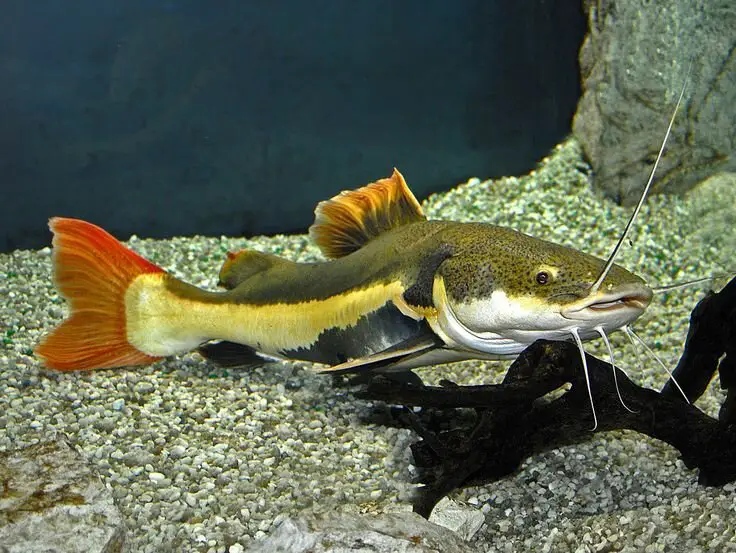
Introduction
In the vast world of aquaculture, picking the right fish for your farm is like picking the right business associate.
The species you choose will ultimately determine how successful you become in the complex world of catfish farming.
This article takes the reader on a thorough exploration of the complexities of catfish farming, exploring the unique traits, needs, and unrealized potential of several catfish species.
Comprehending the unique characteristics of every species of catfish is essential for starting and maintaining a successful aquaculture business.
From the resilient and flexible channel catfish to the rapidly expanding hybrid catfish, each has unique benefits and things to take into account for farmers.
The strategic selection of appropriate catfish species for successful and sustainable farming activities is contingent upon several factors, including but not limited to water quality, temperature tolerance, and feeding patterns.
By navigating these subtleties, you can make sure that your catfish farm thrives in the turbulent waters of the aquaculture sector.

Types of Catfish
Channel Catfish
The channel catfish, demanded for its versatility, is a well-liked option for both beginning and seasoned farmers.
It can survive in a variety of water conditions, has characteristic barbels, and has a voracious appetite. Because of its adaptability to a wide range of conditions, it may be used in warm and cold water systems.
This species, which is known for growing swiftly, reaches market size soon and maximizes revenue for aquaculture endeavors.
Its omnivorous diet allows it to effectively eat a large variety of feed, which lowers operating expenses.
Channel catfish, loved for its delicate taste, is still a popular cooking option, which helps explain why it is still so popular in the aquaculture sector.
Blue Catfish
If size matters, blue catfish dominate. This species may reach remarkable sizes, which makes it a profitable choice for farmers who want to supply a market that prefers bigger catches.
Aquaculturists have noticed the blue catfish’s extraordinary development potential, and this has sparked scientific inquiry as well.
Scientists are investigating the genetic and environmental variables affecting this species’ lean yet vigorous development.
Their research might open up new options for environmentally friendly aquaculture methods and guarantee a steady supply of large blue catfish for the market.
The blue catfish’s capacity to reach large sizes is a result of its streamlined body and effective resource management.
As aquaculture techniques advance, optimizing growth conditions for lean and productive development becomes more and more important, striking a balance between ecological concerns and size-driven market needs.
Flathead Catfish
The flathead catfish, a bottom-dweller with distinct qualities, prefers the depths. Understanding its preferred environment is essential for successful farming.
These amazing animals move silently through murky waters, using their incredibly sensitive barbels to sense their prey.
Their mottled coloring and flattened bodies offer superb concealment against riverbeds, enabling them to attack unsuspecting prey with amazing accuracy.
If one is interested in raising flathead catfish, one must replicate these natural circumstances by giving the fish enough cover and preserving the water quality for their welfare.
Flathead catfish, cunning hunters by nature, play the patient-waiting game, waiting for the right opportunity to attack.
Farmers can optimize farming practices and achieve effective outcomes in this complex underwater environment by implementing strategic strategies that cater to the flathead catfish’s unique hunting preferences.
African Catfish
The African catfish is a lucrative and unique product that is becoming more and more popular. Farmers looking for variety will find it to be an appealing option due to its quick development and flexibility.
Because of its resilience, the fish can live happily in a range of aquatic settings, including recirculating aquaculture systems and freshwater ponds.
One of the main reasons for its success is sustainability; the African catfish uses few resources and has high feed conversion rates.
Its nutritional composition is also noteworthy, providing a substantial amount of protein and important omega-3 fatty acids.
The demand for sustainable and premium seafood is growing worldwide, which puts African catfish even more in the limelight.
The fish is streamlined and sleek, reflecting its efficiency, making it a visually appealing alternative for customers as well as a profitable one for aquaculture.
The African catfish stands out as a durable and ecologically beneficial addition to the world’s expanding seafood market as the aquaculture sector continues to advance.
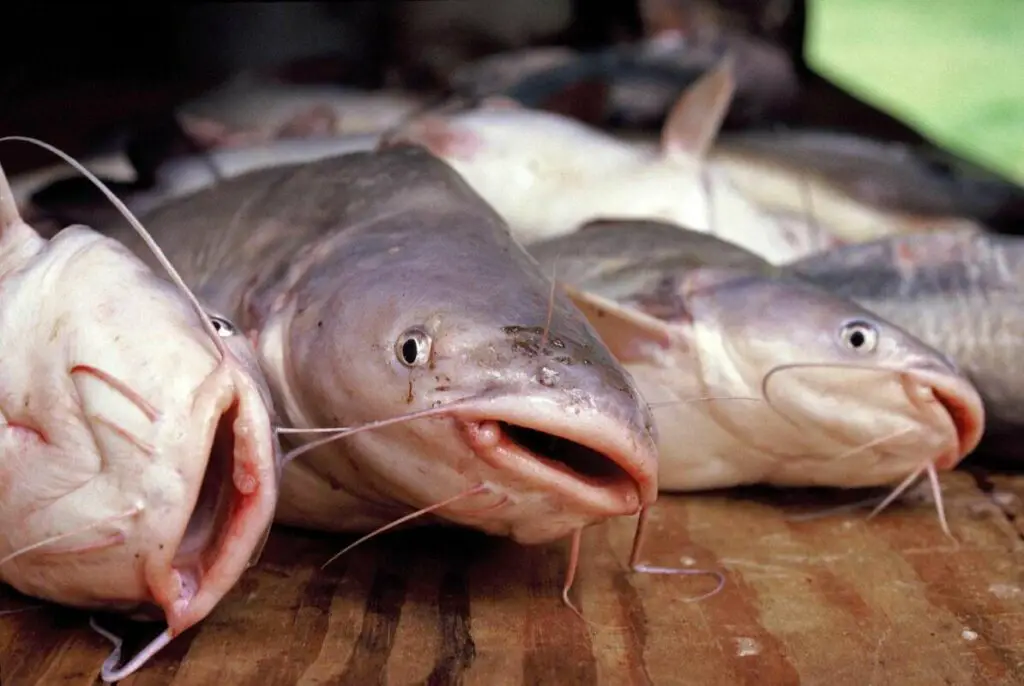
Factors to Consider
A thorough assessment of several important aspects is necessary when choosing the best catfish for your farm, with an emphasis on establishing a healthy aquatic habitat.
Water quality has a significant impact on the overall health and growth of the species as well as the effectiveness of catfish farming.
Feeding behaviors are also very important because different catfish species have distinct food preferences.
It’s critical to evaluate the growth rate to make sure it fits your agricultural schedule and objectives.
Furthermore, maintaining a pulse on consumer demand helps with decision-making, which guarantees profitability.
Matching each species’ unique requirements with your specific objectives is paramount for sustainable catfish farming.
By strategically addressing these aspects, you pave the way for a successful venture, fostering optimal conditions for the selected catfish species to thrive and meet both your economic and agricultural aspirations.

Channel Catfish: The All-Rounder
Characteristics and Appearance
With their characteristic forked tails and black patches, channel catfish are an adaptable species that work well in a variety of agricultural situations.
Aquaculturists often choose these catfish because of their solid texture and mild flavor.
The secret to successfully raising channel catfish is to closely monitor ammonia and pH levels in order to optimize water quality.
A properly balanced diet is also essential for their development and general wellbeing.
In the context of sustainable aquaculture, using effective feed formulations and reducing environmental impact through ethical farming methods is critical.
In addition, channel catfish are incredibly versatile, growing in a variety of environments, from recirculating aquaculture systems to freshwater ponds.
Using biosecurity protocols and carefully controlling stocking levels increases their resistance to illness.
Notably, farmers may choose them at a lower cost because of their efficient conversion of feed into meat.
In summary, channel catfish offer a viable aquaculture option that supports the objectives of environmental and economic sustainability due to their distinct traits and versatility.
Ideal Water Conditions
Adequate aeration provides channel catfish with ample oxygen, which is essential for their general well-being and respiratory processes.
Since these aquatic animals require a certain range of temperatures to flourish, effective temperature management is equally important.
Because channel catfish are ectothermic, their body temperature is affected by the water around them.
It’s critical to keep the temperature constant in order to support healthy metabolic rates. Furthermore, adequate temperature regulation and aeration work together to improve nutrient usage efficiency, which helps with nutrient absorption and digestion.
This strengthens the immune system and promotes healthy development, which lowers vulnerability to illness.
In order to reduce stress in the catfish population, farmers and aquaculturists need to periodically evaluate and alter these elements.
Carefully controlling temperature and aeration essentially creates a favorable environment that ensures the health, expansion, and general prosperity of channel catfish farming operations.
Feeding Requirements
Channel catfish, often observed in groups, exhibit gregarious behavior that enhances their general well-being.
These omnivores flourish in their native environment by consuming a wide variety of foods, such as smaller fish and aquatic plants.
Maintaining their growth and encouraging maximum health requires choosing a nutrient-dense, diverse diet high in proteins and other elements.
Specially prepared catfish pellets enhanced with vitamins and minerals partially meet their nutritional needs.
Moreover, adding live prey to their diet reflects their innate foraging behavior and improves cerebral clarity and general health.
Similar to other nocturnal fish, channel catfish are more active at night.
Feeding them during this period, therefore, corresponds with their normal behavior and promotes a stronger and more resilient population.
Aquarists may ensure the flourishing survival of these fascinating aquatic companions by emphasizing a diet that accommodates their varied nutritional needs and behavioral characteristics.
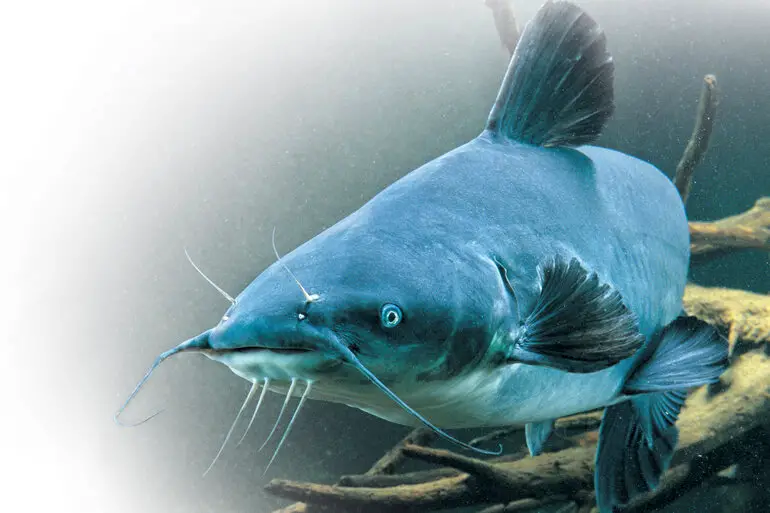
Blue Catfish: A Sizeable Catch
Distinct Features
The smooth skin and startling slate-blue color of blue catfish are distinctive features that make them stand out in aquatic environments.
Understanding these amazing animals’ development cycles is crucial to maximizing their sustainable production.
Scholars have revealed new perspectives on their growth, emphasizing the need to create an environment that meets their dietary requirements.
These catfish, which thrive in environments with regular water quality checks, highlight the importance of aquaculture management techniques.
Creating an environment that supports natural behaviors also enhances their general well-being.
In addition to promoting the health of blue catfish populations, sustainable farming methods and a thorough grasp of these fish growth dynamics also guarantee a robust and prosperous aquaculture sector.
As we explore the complexities of their development, we open the door to the possibility of peaceful cohabitation between these fascinating animals and ethical aquaculture methods.
Best Practices for Growth
To grow to their full potential, blue catfish must have their nutritional requirements well monitored in order to grow to their full potential.
A balanced, nutrient-rich meal provided on a regular basis is necessary to support their best possible growth.
Eating a diet that meets their nutritional needs ensures healthy growth and overall well-being.
It’s important to give blue catfish vast and intriguing habitats in addition to food.
Large environments that closely resemble their natural surroundings are ideal for these fish because they allow them to behave naturally and improve their overall fitness.
Moreover, meticulous water quality monitoring is essential.
It is essential to conduct routine assessments of variables including pH, ammonia, and nitrate concentrations in order to provide a growth-promoting atmosphere.
Keeping the water immaculate reduces stress and strengthens the immune system, which is why blue catfish are so healthy and strong.
To summarize, the combination of adequate food, roomy habitat, and attentive water quality control is essential for maximizing the development potential of blue catfish.
Market Preferences
Larger specimens are continually in demand; therefore, blue catfish farming has been quite popular in recent years. This is a lucrative opportunity for farmers who value size.
Large fillets of blue catfish are in high demand because diners want to eat something special, and eateries want to provide eye-catching food.
Farmers that use sustainable and creative farming methods have an advantage in this cutthroat industry.
To maximize blue catfish development potential, aquaculture techniques such as optimizing water quality and regulated feeding are crucial.
Furthermore, clever marketing that highlights the larger size and better flavor of these catfish may greatly increase sales.
To satisfy the demands of environmentally concerned customers, an emphasis on environmental sustainability and ethical agricultural methods is becoming more and more crucial as the sector develops.
For long-term success, the blue catfish industry is essentially about embracing innovation and sustainability, in addition to quantity.

Flathead Catfish: The Bottom Dweller
Unique Traits
With their large jaws and characteristically flattened heads, flathead catfish are skilled predators who love to eat anything that lives on the bottom.
Because of their unique anatomical structure, they are able to seek and negotiate the substrates of lakes and rivers with great efficiency.
Farmers must carefully plan habitats that suit their unique behaviors of these intriguing critters in order to raise them on farms.
Creating harmonious ecosystems in aquaculture settings ensures that flathead catfish can find their preferred prey, which in turn maintains the fish’s health and growth.
For these ecosystems to resemble their natural environment, elements like hidden places and submerged structures are required.
Furthermore, producers should optimize water quality criteria to maintain the ideal conditions for flathead catfish to thrive.
By following these guidelines, farmers create a sustainable and peaceful aquatic environment in addition to promoting the health of flathead catfish.
Suitable Environments
Flathead catfish rely on the proper substrate and hiding places for their wellbeing, so selecting the suitable pond or tank is essential.
Because it replicates their native habitat, the substrate is essential to maintaining the comfort and general health of these catfish.
Selecting a substrate that closely resembles the bottom of a lake or river, a common habitat for flathead catfish, ensures their safety and allows them to carry out their regular activities, including feeding.
Furthermore, it’s critical to strategically position hiding places throughout the aquatic habitat.
These hiding places, such as caverns or underwater buildings, afford the catfish a sense of security, easing tension and fostering their innate tendencies.
In addition to promoting breeding habits, well-chosen hiding places significantly boost flathead catfish’s overall reproductive performance when kept in captivity.
To summarize, careful, thought-out selection of substrate and hiding places is critical to creating a healthy and happy environment for flathead catfish.
Specialized Feeding Habits
In their native environments, flathead catfish, which are renowned for their remarkable size and raptorial instincts, mostly consume live prey.
In aquaculture environments, producers should use feeding techniques that closely resemble the natural hunting habits of catfish in order to raise a robust population.
Not only does adding live bait, such as minnows or tiny fish, stimulate the catfish ponds’ predatory tendencies, but it also gives the fish a balanced, nutrient-rich diet.
Furthermore, using an environmentally friendly aquaculture strategy that includes enrichment can improve the catfish’s general health.
This involves building pond structures that encourage physical activity and mimic underwater hiding places.
By integrating these innovative techniques, farmers can not only optimize the growth and health of their flathead catfish but also contribute to the development of more ecologically balanced aquaculture practices.
How to Identify the Perfect Catfish to Raise
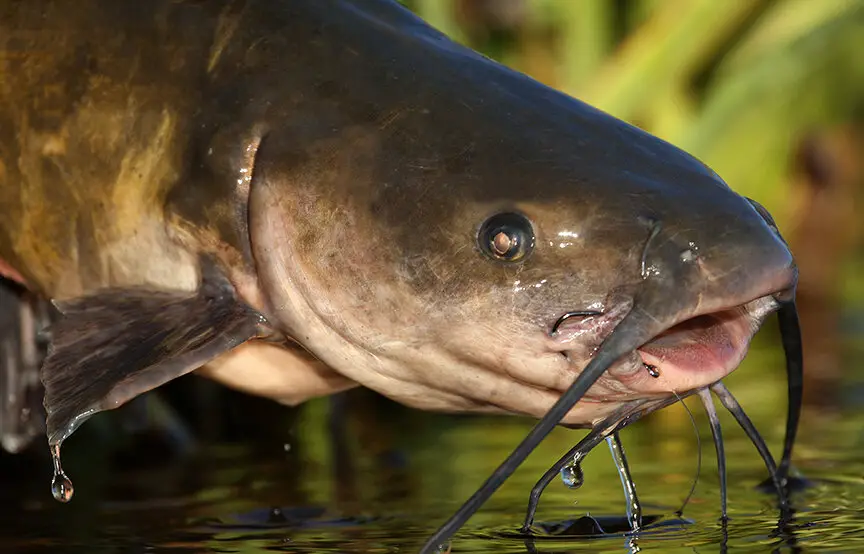
African Catfish: Exotic and Profitable
Introduction to African Catfish
The sleek and quick African catfish has become a global favorite in aquaculture due to its extraordinary flexibility and quick development.
Despite its watery origins, this species has successfully spread around the planet, appearing sleek and durable in a variety of environmental circumstances.
Its voyage from African seas to worldwide aquaculture ponds demonstrates its innate capacity to flourish in a variety of environments.
Thanks to its lean body and effective use of nutrients, this catfish has gained popularity among fish farmers and is now a common ingredient in dishes served all over the world.
People all over the world can use it in a variety of recipes due to its hard yet slippery texture and subtle flavor.
The African catfish’s graceful rise from an obscure locality to international recognition is evidence of its adaptability, and it has become a symbol of aquaculture success.
Adaptability and Growth
African catfish are renowned for their versatility; they flourish in a wide range of aquatic settings and exhibit incredible resistance to changing circumstances.
Their hardy character adds to their broad appeal to fish growers looking for a dependable and low-maintenance species.
These catfish develop exceptionally fast, reaching market size quickly and effectively. Their distinctive whisker-like barbels set them apart.
Catfish are advantageous to fish farming enterprises because of their quick growth and effective feed-to-flesh conversion.
Because of their efficiency, they are a financially sensible option for aquaculture endeavors.
Furthermore, the catfish’s tolerance for various water conditions enables it to thrive in brackish and freshwater settings.
Because of their increased flexibility, fish producers may raise them in a variety of environments.
Many places highly value African catfish for their sustainable aquaculture methods, which support food security and economic growth. These advantages, both ecological and economic, are a result of their cultivation.
Market Potential
The market’s attraction to African catfish provides farmers seeking a unique edge with lucrative options.
African catfish have extraordinary adaptation to a wide range of aquatic settings, enabling them to flourish under varying farming circumstances and offer resilience in the face of environmental problems.
In addition to ensuring a more consistent yield, this flexibility allows farmers to explore a variety of geographic areas for aquaculture.
African catfish’s unique flavor, which is defined by its mild and delicate taste, meets the increasing need of consumers for unusual culinary experiences.
As a result, by appealing to consumers looking for an alternative to more popular fish kinds, producers may use this unique flavor to carve out a niche market.
The sustainable agricultural techniques associated with African catfish bolster the environmentally conscious consumer trend, further appealing to this market.
When farmers adopt these sustainable techniques, African catfish products are more appealing to consumers because they not only support international conservation efforts, but also establish themselves as leaders in moral and responsible aquaculture.

Setting Up Your Catfish Farm
To succeed, a catfish farm requires meticulous planning. Every stage of the process, from setting up the pond to choosing the ideal species combination, adds to the project’s final success.
Maintaining a healthy catfish ecosystem is heavily reliant on managing water quality. Installing efficient aeration systems ensures adequate oxygen levels, promoting ideal development.
Selecting a catfish-specific nutritional diet enhances their health and accelerates their growth.
Frequent health monitoring, including check-ups and preventative actions, protects against potential illnesses and increases the resilience of the farm.
Strategic marketing tactics are critical for ensuring that the product reaches its intended audience and promoting profitability.
Furthermore, using sustainable procedures demonstrates the catfish farm’s commitment to environmental care, which appeals to environmentally conscious customers.
All things considered, a comprehensive strategy that includes creative methods and technological integration for efficiency builds a strong basis for a successful catfish farming business.

Feeding Strategies for Success
Optimizing feed formulas is crucial for the success of a catfish farm.
Achieving equilibrium among vital nutrients such as proteins, lipids, and vitamins is critical for catfish’s overall well-being and development.
The size and age of the catfish are important considerations because they affect their dietary requirements.
Following meal schedules also promotes healthy development rates by increasing efficiency and preventing overfeeding or underfeeding.
Having a thorough grasp of the nutritional needs of catfish is essential to creating meals that promote their health.
Farm operators can cater to unique dietary demands, promoting immunity and resilience against illnesses, by utilizing a wide variety of superior nutrients.
In conclusion, running a catfish farm holistically requires understanding the unique nutritional needs of catfish, optimizing feed formulas, and adhering to feeding schedules.
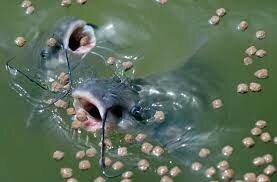
Overcoming Challenges
Catfish producers deal with a variety of difficulties, ranging from managing diseases to market swings.
The secret to getting beyond these challenges and guaranteeing long-term success is putting beneficial plans into action.
Sustainable aquaculture techniques are critical for preventing illness and creating a favorable environment for catfish growth.
By deliberately diversifying their product line, catfish producers can lessen the effects of market swings.
Additionally, using cutting-edge technologies improves operating efficiency. These include automated feeding systems and water quality monitoring.
Combining these technologies positions catfish farms to increase output and be more resilient against unforeseen obstacles.
Furthermore, encouraging cooperation between catfish farmers via knowledge-sharing networks might yield insightful information and group problem-solving.
Catfish farmers may successfully manage the difficulties of their sector and achieve long-term success by using a comprehensive approach that incorporates sustainability, diversification, innovation, and teamwork.

Catfish Farming Sustainability
Aquaculture that is sustainable places a strong emphasis on the value of ecological balance.
Farmers reduce their environmental impact by implementing eco-friendly techniques.
We avoid overexploitation of catfish and ensure population stability by using ethical harvesting methods.
Furthermore, sustainable catfish farming incorporates social responsibility in addition to environmental concerns.
One important component of building a healthy relationship between the farm and its surroundings is actively participating in and making positive contributions to the local community.
This may be lending a hand to regional companies, creating job possibilities, or participating in neighborhood projects.
Sustainable farming methods benefit not only the environment and society, but they also help catfish producers become more profitable over time by increasing their efficiency.
By balancing these various factors, we can produce a holistic approach to catfish farming that encourages a model that is not only commercially successful but also socially and environmentally responsible.

Success Stories in Catfish Farming
Starting a catfish farm necessitates a deep comprehension of the complexities inherent in aquaculture, not just a rudimentary study of it.
Gaining knowledge from industry leaders might greatly improve one’s chances.
Prosperous catfish producers, often called aquademics, freely impart their knowledge and serve as role models for others.
These wise old people share not just their tales but also important pearls of knowledge.
Success depends on overcoming obstacles, understanding the nuances of managing water quality, and being proficient in feeding methods.
These mentors also stress the value of implementing sustainable practices and the role that innovation plays in boosting yields while reducing environmental damage.
Rather than viewing these ideas as anecdotes, aspiring catfish farmers should view them as a strategic road map for starting a successful catfish business.
Often, the footprints of those who ventured before, leaving a legacy of knowledge for future generations, pave the way for success in catfish farming.

Future Trends in Catfish Farming
Technological developments in recent years have brought about a revolutionary shift in the catfish farming industry, transforming long-standing habits.
The use of sensors and data analytics in smart aquaculture systems has made it possible to monitor water quality, adjust feeding schedules, and increase overall productivity.
These developments demonstrate a dedication to ecological objectives while also enhancing output.
It is now essential to incorporate ecologically friendly methods, such as water recirculation and feed compositions that consider the environment.
In response to the increased customer demand for premium and specialized catfish products, market trends are driving the sector towards varied product offerings, even beyond technological advancements.
The landscape of catfish farming is changing to satisfy demands for ethical and responsible aquaculture as the world’s population grows more aware of its food sources.
With a dynamic and promising trajectory, the future of catfish farming is a complicated tapestry woven with threads of innovation, sustainability, and customer preferences.

Conclusion
Choosing the right catfish for your farm requires planning and a careful assessment of several variables.
It is important to give this careful thought, since your catfish farming endeavor will fail if you do not grasp the unique characteristics of each species.
Start by learning about the unique needs of different kinds of catfish, taking into account things like size, development rate, and preferred environments.
Equipped with this knowledge, plan your farm’s structure and layout to meet the unique requirements of the selected species.
By implementing effective feeding and management techniques that ensure the catfish’s optimum growth and well-being, you further improve your strategy.
To create a profitable and sustainable catfish farm, take into account elements like feed quality, feeding schedules, and pond upkeep.
By implementing a well-planned strategy that includes these essential components, you may establish the foundation for a successful catfish farming business.
FAQs
What water conditions do channel catfish prefer?
Channel catfish thrive in well-aerated water with controlled temperatures, ideally between 75 and 85°F.
How can I optimize the growth of blue catfish?
Consistent feeding, providing spacious environments, and monitoring water quality are crucial for maximizing the growth of blue catfish.
What is the primary diet of flathead catfish?
Flathead catfish predominantly feed on live prey, and farmers should implement feeding strategies that mimic their natural hunting behavior.
Why are African catfish considered exotic?
African catfish are considered exotic due to their origin in African waters, their unique adaptability, and their rapid growth.
What are some sustainable practices in catfish farming?
Sustainable practices include eco-friendly farming methods, responsible harvesting, and positive contributions to the local community.
Hooked on Tech: Exploring the latest Fishing Gadgets that Anglers swear by.
In the realm of angling, where tradition and technology often converge, a new wave of fishing gadgets has emerged, transforming the way anglers approach their craft.
From advanced fish finders to smart bait systems, these innovations have not only revolutionized the fishing experience but have also garnered a loyal following among anglers worldwide.
KastKing Paradox 4.5-Inch Fishing Scissors, Stainless Steel Precision Fishing Line Cutters With Non-Slip Grip, Protective Sheath, and Neck Lanyard, Small Scissors for Braided Fishing Line
$7.99 (as of November 18, 2025 02:18 GMT +00:00 – More infoProduct prices and availability are accurate as of the date/time indicated and are subject to change. Any price and availability information displayed on [relevant Amazon Site(s), as applicable] at the time of purchase will apply to the purchase of this product.)Berkley PowerBait Chop Block Fishing Soft Bait
Now retrieving the price.
(as of November 18, 2025 22:28 GMT +00:00 – More infoProduct prices and availability are accurate as of the date/time indicated and are subject to change. Any price and availability information displayed on [relevant Amazon Site(s), as applicable] at the time of purchase will apply to the purchase of this product.)RUNCL Braided Fishing Line Merced, 1000 500 300 Yards Braided Line 4 8 Strands, 6-200LB – Proprietary Weaving Tech, Thin-Coating Tech, Stronger Smoother for Freshwater Saltwater
$18.99 (as of November 18, 2025 04:58 GMT +00:00 – More infoProduct prices and availability are accurate as of the date/time indicated and are subject to change. Any price and availability information displayed on [relevant Amazon Site(s), as applicable] at the time of purchase will apply to the purchase of this product.)KastKing Intimidator Bait Knife and Filet Knives, Ultra-Sharp G4116 German Stainless-Steel Blades, Fresh or Saltwater, Non-Slip Handle, Durable Storage Bag, and Honing Rod
$59.99 (as of November 18, 2025 02:18 GMT +00:00 – More infoProduct prices and availability are accurate as of the date/time indicated and are subject to change. Any price and availability information displayed on [relevant Amazon Site(s), as applicable] at the time of purchase will apply to the purchase of this product.)Clear Fishing Line Wire 755 ft, Invisible Monofilament Fishing Line Wire, Nylon String for Hanging Balloons Garland Crafts Picture Decorations, Clear String Threads Cords WUINOID
$5.49 (as of November 18, 2025 04:58 GMT +00:00 – More infoProduct prices and availability are accurate as of the date/time indicated and are subject to change. Any price and availability information displayed on [relevant Amazon Site(s), as applicable] at the time of purchase will apply to the purchase of this product.)Calamus BladeVolt Rechargeable Cordless Electric Fillet Knife with 7″ & 9″ Blades, 27,000 RPM Motor, Type-C Battery, Non-Slip Grip & Safety Lock, Portable Carry Case, Fishing Gear and Gifts for Men
$47.99 (as of November 18, 2025 22:28 GMT +00:00 – More infoProduct prices and availability are accurate as of the date/time indicated and are subject to change. Any price and availability information displayed on [relevant Amazon Site(s), as applicable] at the time of purchase will apply to the purchase of this product.)Mini Fishing Kits Bulk Small Emergency Survival Fishing Kits Outdoor Compact Fishing Tackle Kits with Case for Beginner Christmas Shoebox Fillers for Age 9-14 Fishing Party Favors
$26.99 (as of November 18, 2025 22:28 GMT +00:00 – More infoProduct prices and availability are accurate as of the date/time indicated and are subject to change. Any price and availability information displayed on [relevant Amazon Site(s), as applicable] at the time of purchase will apply to the purchase of this product.)KastKing SuperPower Braided Fishing Line – Abrasion Resistant Braided Lines – Incredible Superline – Zero Stretch – Smaller Diameter – A Must-Have!
$16.99 (as of November 18, 2025 04:58 GMT +00:00 – More infoProduct prices and availability are accurate as of the date/time indicated and are subject to change. Any price and availability information displayed on [relevant Amazon Site(s), as applicable] at the time of purchase will apply to the purchase of this product.)HEETA Fish Scale with Backlit LCD Display, Up to 110lb/50kg Digital Portable Hanging Fish Weight Scale with Hook & Measuring Tape for Home, Farm, Outdoor, Hunting, Fishing, 2 AAA Batteries Included
$8.99 (as of November 18, 2025 02:18 GMT +00:00 – More infoProduct prices and availability are accurate as of the date/time indicated and are subject to change. Any price and availability information displayed on [relevant Amazon Site(s), as applicable] at the time of purchase will apply to the purchase of this product.)OCQOTAT Florida Saltwater Fish& Shark Identification Set–4 Double-Sided Waterproof Quick-Reference Fishing Guide Cards with FWC Rules,Size Limits&80+ Fish&Sharks in Real Photos| Ring Binding,8.2x6inch
$9.99 (as of November 18, 2025 22:28 GMT +00:00 – More infoProduct prices and availability are accurate as of the date/time indicated and are subject to change. Any price and availability information displayed on [relevant Amazon Site(s), as applicable] at the time of purchase will apply to the purchase of this product.)Fusion X Fishing – Xcube Soft Plastic Plastisol Fishing Lure Making Cubes – Single Pack 2.8 fl oz – 225 Colors – Make Your own Soft Plastic Rubber Fishing Lures.
$3.00 (as of November 18, 2025 23:58 GMT +00:00 – More infoProduct prices and availability are accurate as of the date/time indicated and are subject to change. Any price and availability information displayed on [relevant Amazon Site(s), as applicable] at the time of purchase will apply to the purchase of this product.)Southern Salt Hoodwink 4.75″ Soft Plastic Fluke Lure – Weedless Design with Weighted Tail Ball – 5-Pack for Redfish, Trout, Flounder & Bass – Jig Head Ready
$8.99 (as of November 17, 2025 06:42 GMT +00:00 – More infoProduct prices and availability are accurate as of the date/time indicated and are subject to change. Any price and availability information displayed on [relevant Amazon Site(s), as applicable] at the time of purchase will apply to the purchase of this product.)RUNCL ProBite Lipless Crankbait, Vibe Cranks 1/4oz 3/8oz 1/2oz 5/8oz, Hard Fishing Lures – Lifelike Design, Loud Rattles, Precise Weighting System, Tight Wobble Action
Now retrieving the price.
(as of November 18, 2025 22:28 GMT +00:00 – More infoProduct prices and availability are accurate as of the date/time indicated and are subject to change. Any price and availability information displayed on [relevant Amazon Site(s), as applicable] at the time of purchase will apply to the purchase of this product.)

























